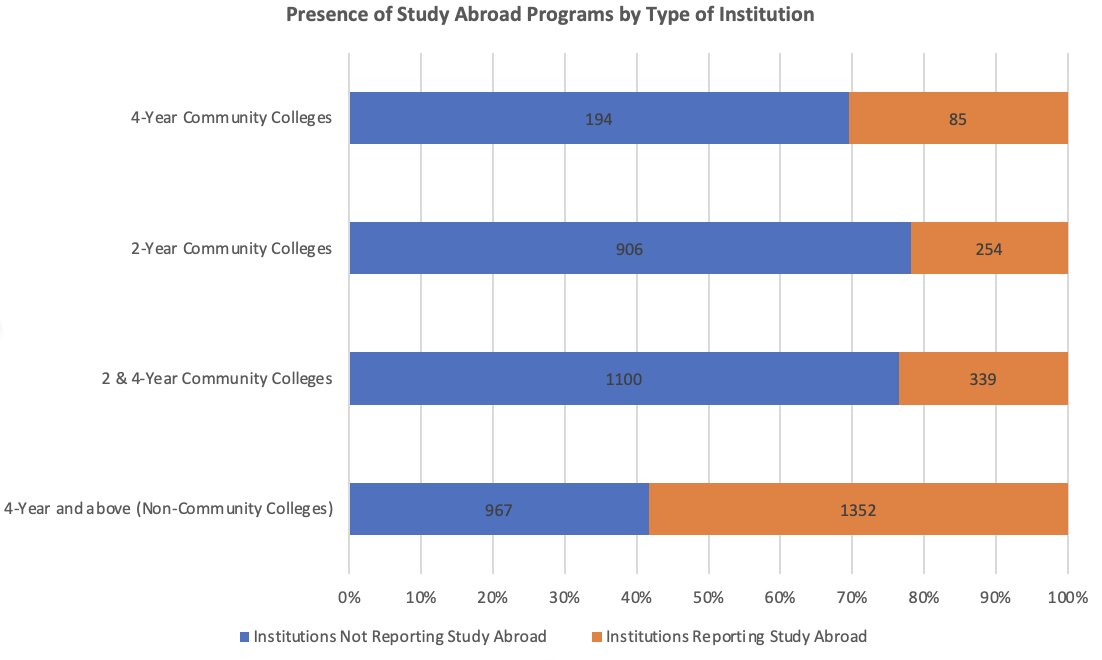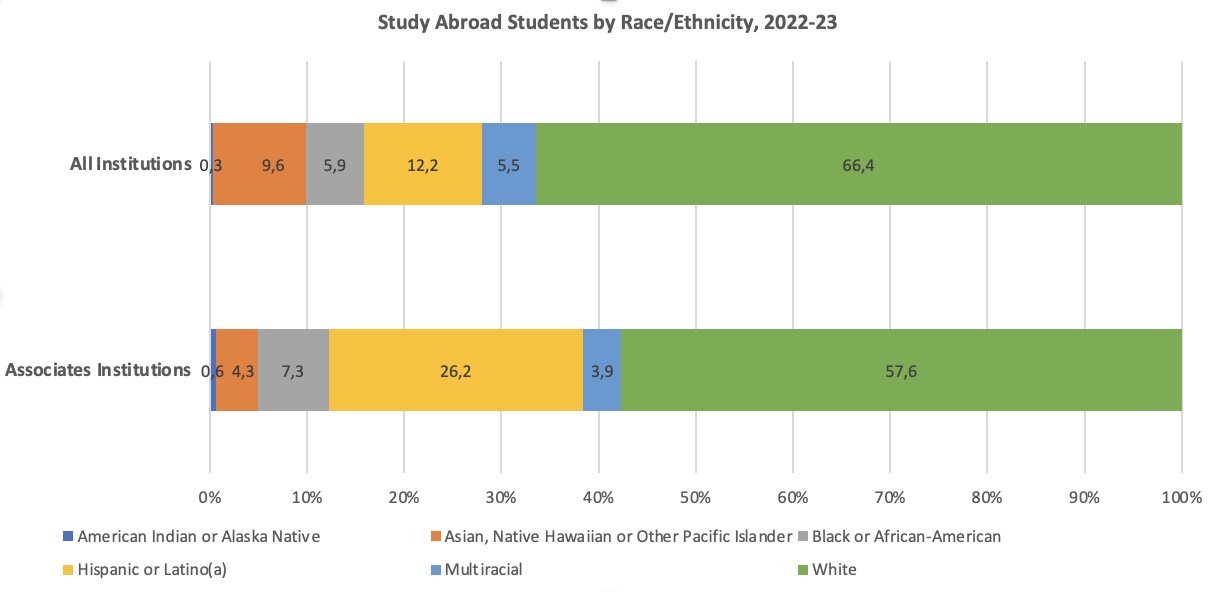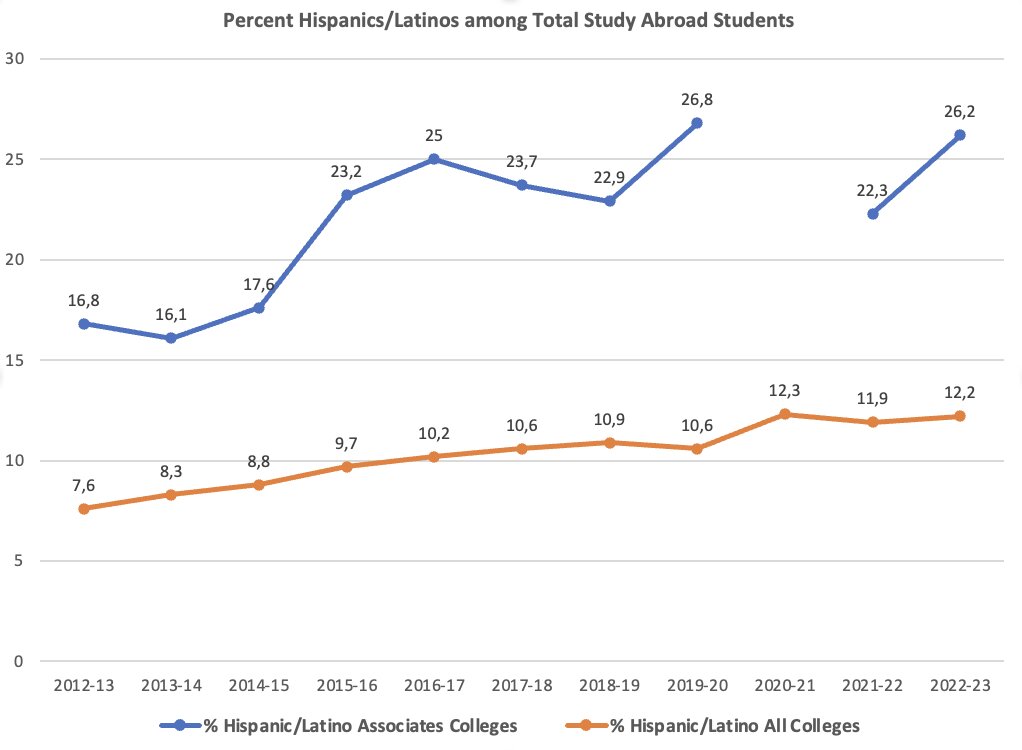Study abroad programs are typically associated with four-year colleges and large research universities; indeed, the vast majority of study abroad students attend these types of institutions. According to the Institute of International Education (IIE)’s 2024 Open Doors report, 280,716 U.S. students studied abroad for academic credit in the 2022-23 academic year; of these, only 4,772 came from associate’s institutions (less than 2% of the total).
Nonetheless, it is important to focus on this sub-section of study abroad students for two reasons. First, due to the flexible, cost-effective nature of community colleges – which enroll larger numbers of under-represented, lower-income, immigrant and first-generation college students – they are primary catalysts of upward mobility and inclusion in American society. Thus, their study abroad programs are ideally placed to broaden access to the world for sectors of the population that would otherwise find it more difficult to go overseas. In fact, community colleges send a more diverse group of students abroad than other types of institutions (as will be shown below). This is particularly relevant for Hispanic/Latino students, given that a large proportion of them begin their higher education trajectory at community colleges. Second, it has been well documented that studying abroad has multiple benefits not only for individual students’ personal growth, but also for the broader development of the industries and communities that these students will work in, as they contribute their international expertise, language skills and adaptable, multicultural capabilities. Thus, if opportunities for community college students to study abroad are supported and their numbers increase, the impact will be felt across the large numbers of local towns and industries that community colleges are embedded in and serve.
This article provides a general profile of study abroad at community colleges, based on IIE’s Open Doors report[i] and NCES’ IPEDS data. It also highlights the participation of community college students in the federal Gilman Scholarship program, which has provided essential financial support for thousands of lower-income students to study abroad since 2001, and is now threatened by federal funding cuts. Finally, this article illustrates the overlap between the top study abroad-producing community colleges and the top community colleges serving Hispanic/Latino students.
Community College Study Abroad Growth Trends: Post-Pandemic Recovery
Participation in study abroad programs at all types of higher education institutions grew steadily over the past two decades, until the 2020/21 Covid19 pandemic, which naturally had a devastating effect on all international exchange programs. Since then, study abroad programs have recovered at a relatively rapid pace, across all higher education sectors. Nonetheless, overall study abroad participation for academic credit in 2022-23 (a total of 280,716 students) had not yet recuperated up to the level of a decade earlier (2012-13, when there were a total of 289,408 students). In the case of Community Colleges, the 2022-23 number of study abroad participants for academic credit (4,772) was still around a thousand less than it was in 2012-13, when it had reached 5,907 students.

Availability of Study Abroad Programs at Community Colleges
An analysis of NCES IPEDS data reveals that out of all 3,758 accredited, degree-granting U.S. higher education institutions (2-year, 4-year and above), nearly half reported having study abroad programs in 2022-23. The type of study abroad program is not specified – it could be only a couple of faculty-led courses, a series of larger college-hosted programs, or tie-ups with external providers or consortiums.
When broken down into sub-sectors, this data indicates that more than half (58%) of baccalaureate and graduate institutions (4-year and above, offering primarily B.A., M.A. or PhD degrees) offer some sort of study abroad programs to their students, while only about one-quarter (24%) of all associates’ colleges (2- or 4-year – those offering only associates’ degrees as well as those offering both associates and some bachelor’s degrees) have study abroad programs available. This percentage is lower among 2-year community colleges than among 4-year ones (22% and 30% respectively, as shown below).
Nonetheless, the reported availability of some form of study abroad at community colleges is more widespread than might be expected. It is notable that while community colleges represent around 20% of all institutions offering some form of study abroad, the total number of community college study abroad students for academic credit represent only 2% of all study abroad participants for academic credit. This discrepancy between the availability of study abroad programs and actual participation poses important questions about the role of funding and outreach in boosting the apparently low enrollment of community college students in their institutions’ study abroad offerings.[ii]

Diversity of Community College Study Abroad Students
Since community colleges generally serve more diverse sectors of American society than other higher education institutions, including a large proportion of traditionally under-represented groups, it is not surprising that this diversity is also reflected among study abroad students. According to IIE data dating back to 2003-04, the proportion of community college study abroad students who are African-American/Black and Hispanic/Latino has consistently been higher than the proportion of these groups among study abroad students at colleges overall; this was still the case in 2022-23, the latest data available.

Over the past two decades, there has been a steady increase in the proportion of Hispanic/Latino study abroad students at community colleges. Since 2015, more than 20% of all community college study abroad students have belonged to this community (with the exception of the Covid19 pandemic year, 2020-21, when data was not reported).

Top Host Regions and Destinations for Community College Students
In 2022-23, the top destinations for community college students were very similar to those of study abroad students overall; the only difference was a higher ranking for Mexico among community college students (in 7thplace instead of 13th for all study abroad students).
Top Destinations for Study Abroad Students at Associates Colleges, 2022-23

With regard to host regions, community college students have travelled to Africa, the Middle East/North Africa and Oceania in smaller proportions that study abroad students overall, while the proportion of students choosing Europe and Asia is similar for both groups. Over the past two decades, at least 50% of both community college students and students at all institutions have travelled to Europe for their study abroad experiences.
With regard to Latin America, it is notable that since 2003-04, a greater proportion of community college study abroad students have gone to this region than study abroad students overall. After reaching an unusually high peak during the Covid19 pandemic, however, the proportion of community college students studying abroad in Latin America has decreased to below 20% for the first time in two decades.

Funding Study Abroad at Community Colleges: Federal Support through Gilman Scholarships
Community Colleges receive a large proportion of their income from state and local levels, and many of them provide scholarships for their students to study abroad from their own funds or those of state-level governments, corporations and philanthropic organizations. At the same time, however, federal government funding offers key financial support for lower-income students at community colleges, particularly through Pell Grants and federal student loans. Students who are eligible for Pell Grants are also eligible for federal Gilman Scholarships, which provide support for studying abroad.
Founded in 2001 and named after late congressman Benjamin A. Gilman (R-NY), the Gilman Scholarship Program is funded through the U.S. Department of State, with the overall aim of allowing American youth to gain “a deeper understanding of their place in the world”, in Gilman’s words, as well as to further international understanding and develop future leaders who can advance U.S. national security and economic interests. In order to obtain a Gilman Scholarship, students must be U.S. citizens, prove financial need (be a Pell Grant recipient), be in good academic standing, and applying for or accepted to a credit-bearing study abroad or internship abroad program.
This prestigious program provides each Gilman Scholar with a maximum of $5,000 dollars towards covering the costs of study abroad. It provides students with much more than financial support, however: it also provides access to a network of Gilman Scholars across the nation, career development opportunities, non-competitive eligibility for government employment, and international seminars, as well as the opportunity to become Alumni Ambassadors who mentor other students that are considering studying abroad and applying to the Gilman Program. Additions to the Gilman Program include funding specifically for study abroad STEM programs, for critical language studies, and the Gilman-McCain Scholarship for military families.
Over the past 22 years, the Gilman Scholarship Program has supporting access to study abroad for more than 44,000 undergraduate students at 1,386 colleges and universities across the country. Nearly 60% of Gilman Scholars come from small towns or rural communities, and nearly half are first-generation college learners, a large proportion of whom attend community colleges.[iii]
According to Tammy Gibbs, International Education Coordinator at Madison College, students who had never been abroad and were given the opportunity to do so through the Gilman Program were inspired to try new career paths and explore even more about other cultures. “Perhaps most importantly”, she added, “the Gilman Program has allowed them to experience something they never thought possible given their background, economic status, or decision/need to study at a community college."[iv]
Yvonne Schmidt, a Study Abroad Advisor at Mesa Community College, agrees that "the Gilman Program is more than just a scholarship for our students. It provides an opportunity to open up the world and expand the horizons of our students who may never have left their home state or the United States. They come back looking at life through a broader global lens. Students have added international components to their majors or careers, gotten involved in student government, transformed as individuals, and encouraged other students to study abroad."[v]
In mid-February of this year, State Department grant funding recipients were abruptly informed that funding for international exchange programs, including Fulbright and the Gilman Program, was suspended temporarily. This caused current Gilman scholars to be left without promised financial disbursements, and also halted the application process for new scholarships. According to NAFSA: Association of International Educators, by the end of March, 85% of funding had been restored through new State Department payment mechanisms. Nonetheless, given the current administration’s emphasis on downsizing and eliminating federal government programs and on reducing international engagement, NAFSA, the Forum on Education Abroad and the Alliance for International Exchange, among others, are urging Congress to uphold and ensure the continued funding of these programs, which the administration is legally directed to implement.[vi]
Top Study Abroad Community Colleges and Hispanic/Latino Students
The following list of top study abroad producing community colleges for 2022-23, provided by IIE, shows that more than half are Hispanic Serving Institutions; those highlighted in gold (half of the total) are also on Hispanic Outlook’s lists this month of Top 50 Community Colleges for Hispanics/Latinos (due to their high enrolment of these students).

[i] All IIE data cited in this article refers to “students studying abroad for academic credit”, although they may be referred to simply as “study abroad students” for the sake of clarity.
[ii] This discrepancy might not be as severe as mentioned here, depending on the methodology used to define “community colleges” and study abroad students. IIE refers to “Associates Colleges” and defines these based on NCES Carnegie classifications, but does not specify which classification codes were included. If IIE used only those classification codes which mention “Associates Colleges”, then it would have a narrower definition of this sector (perhaps limited only to 2-year colleges) than the definition used to formulate Hispanic Outlook’s lists of Community Colleges, which also include 4-year colleges with Carnegie classification codes that refer to “Mixed Associates/Bachelor’s Colleges”. In addition, the IIE Open Doors data on study abroad students used for this article refers to “students studying abroad for academic credit”, which excludes students studying abroad in non-credit programs or internship/volunteering experiences, among others. Adding all of these students might expand to some extent the figures on “community college study abroad students”.